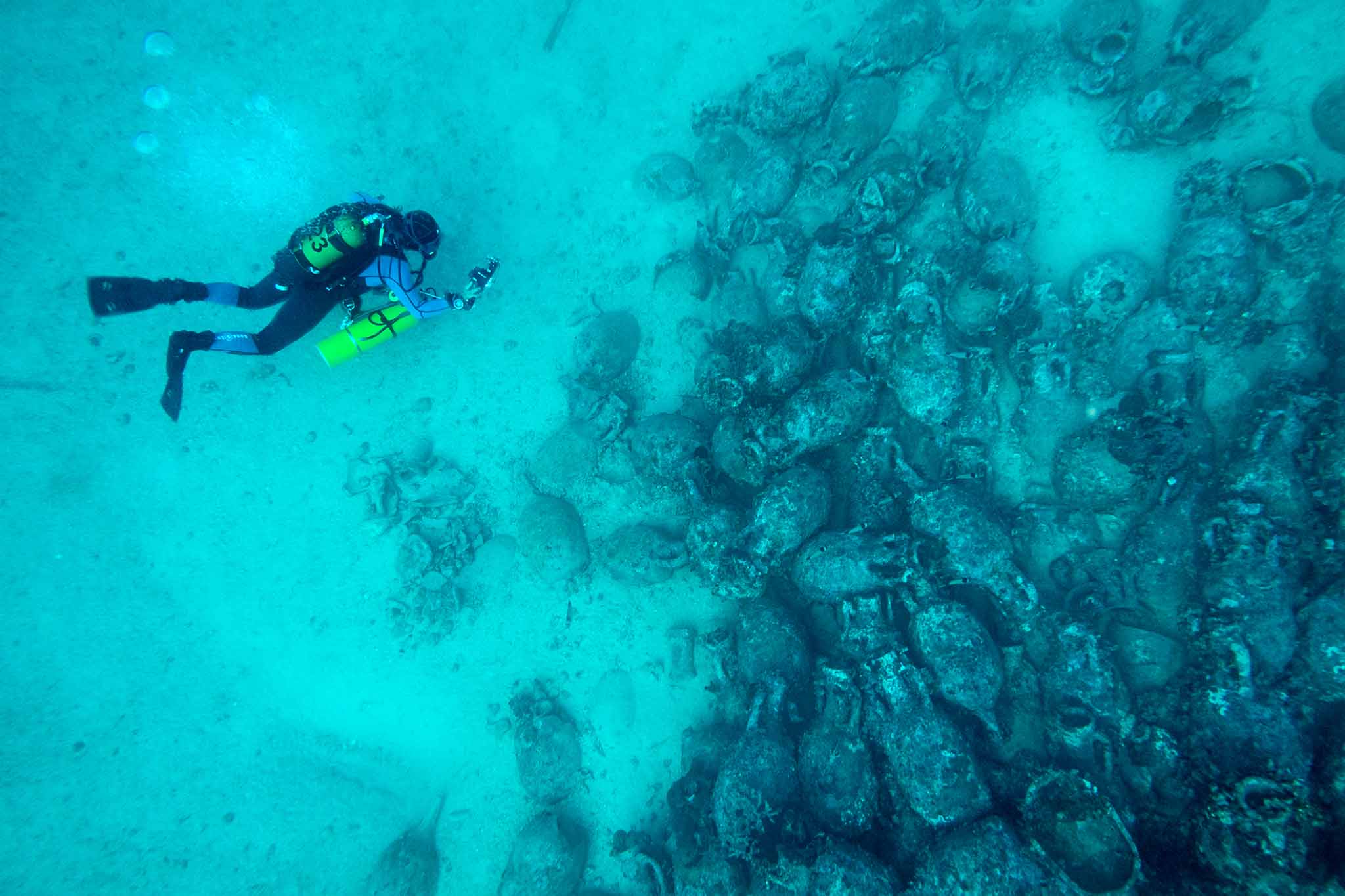We have published on Sketchfab our new, even more detailed scan of the ancient Roman wreck found near the Croatian island of Šćedro. This ship sank about 2000 years ago and to this day rests almost intact at a depth of 45 meters. It is one of a few currently known such well-preserved wrecks from that time, which makes it a unique find.
We previously published our preliminary scan of this wreck back in 2020, but the more detailed model, until recently, was only available for archaeologists’ research. Now everyone can check it out on their own computer or phone and it’s completely free!
Archaeological work in secret
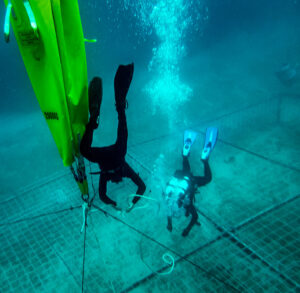
The research on the wreck is led by Tea Katunarić – an archaeologist from the University of Split. Archaeological work began about 3 years ago and most of the time was kept secret. In addition, the location itself was known only to a few people. It was feared that this valuable find could be stolen, if only the information got into the media. Only when the wreck was secured with a special steel cage, everyone involved was finally allowed to talk more about the find.
Modern digital technologies in underwater archaeology
Underwater archaeological research usually consists of many individual dives and each of them has a specific goal and action plan. Such activities include, for example, viewing the wreck, drawing its sections, measuring individual elements or doing underwater excavations. However, in this case, the wreck is quite deep, which limits the time that divers can spend on it to only a dozen or so minutes each time. Thus, a different approach had to be taken, largely based on modern digital technologies. And that’s where we jumped in!

First, together with Piotr Stós (Nautica Vis Diving Centre), during one dive we collected large amounts of digital photographic data, a total of over 2000 photos. Then, based on them, we created the first detailed 3D model of the wreck, that shows each amphora and their position. Thanks to this, archaeologists got the first map and could plan their further activities. We on the other hand, used the initial map to begin planning even more accurate scan, this time based on photos from many dives. When the archaeologists went to Šćedro again some time later, we joined them and proceeded to scan the wreck for the second time.
Although the wreck lies quite close to the island, there is no easy access to it from the shore. So, we had to dive from the boat. Fortunately, a special, very strong rope was put there, along which divers can efficiently descend to the wreck and ascend back, and to which a diving boat can be moored.

As we were descending to 45m, we had to do decompression dives. It means we could not immediately ascend back to the surface after finishing photographing, as it is the case with non-decompression dives. Instead, on the way back to the boat, we had to spend enough time at different depths to safely get rid of excess nitrogen from the body along with the exhaled air. The time of decompression depended on the time spent photographing. The longer we were at the bottom, the longer the way back took. And therefore, we had to plan our dives very carefully and take more cylinders with us to have adequate air supplies for the way back, as well as for all unforeseen situations.

On the island of Šćedro, no one lives all year round. There are only two or three seasonal restaurants and a few lucky people have their summer houses there. So while sometimes someone could help in something small, in diving matters we could only count on ourselves. The nearest compressor we could use for filling our cylinders was in the village of Zavala on the neighboring island of Hvar, a few kilometers by boat and was available only occasionally. In addition, we had to also pay attention to weather conditions. It was simply not always safe to sail to Hvar. So we filled the cylinders only on the days, when it was possible, which meant that sometimes we had downtime in the project, because there was no air to dive on. There were also some challenges with electricity, because on the island there is only access to solar panels and batteries. Therefore, we had to plan what to plug and when, so we would continuously have enough power for all essentials.

In total, we dove on the wreck over a dozen times and took several thousand photos. It took us several weeks to process these photographs and create the new 3D model based on them. But when it was finally ready, it captivated scientists with details that they could now analyze without going into the water. This reduced the cost of their research and also allowed non-diving professionals to take a look at this discovery. In addition, our model allowed all of us to see the wreck as a whole, which in reality can be difficult due to limited visibility under water.
For a long time, the model was only available to researchers, but now we can finally publish it and make it possible for everyone interested to take a virtual underwater tour on the ancient Roman wreck.
Model of the Roman wreck
As you can see on the model, the wreck is mostly covered with sand and sediment, so for now we can only see a part of the cargo, probably less than half of it. It is several hundred amphorae, at least two types and each is about 1m high. Specialist visual inspection of the shape of several of them allowed to determine their age to the century in which they were used – II-I century BC.
The visible amphorae are arranged in the shape of a boat, so we can approximate its size. It’s about 15-18 meters long and 6-7 meters wide. There is also a small space between the amphorae, where the mast most likely was. However, the archaeologist Tea Katunarić, who is leading the underwater research, is convinced that these amphorae are just the beginning, because it is possible that under the sand other treasures are waiting to be discovered.
What were these amphorae used for
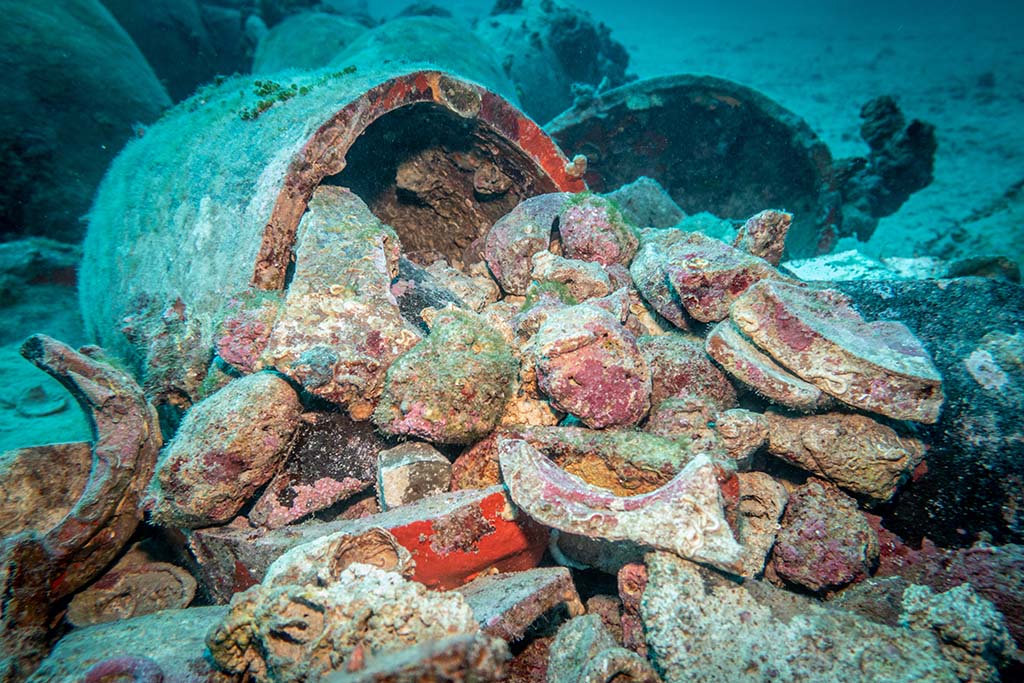
Wine or olive oil was usually transported in this type of vessel, so you can expect that was the case here. Especially since some of the amphorae still have original plugs, although currently pushed deeper into the neck by the water pressure prevailing at this depth. However, we will have certainty only after a special chemical analysis of the content is performed.
There are also amphorae without plugs, empty, as well as those that seem to be filled with stones, most likely ballast. The ships used in those days did not have centreboards. Because of that, they were less controllable and less stable in more difficult weather conditions, especially when they sailed without cargo. Therefore, ballast stones were commonly used every time the ship was too light for safe navigation. So it seems that in this case, some of the amphorae before departure were empty and someone filled some of them with stones to make the boat heavier.
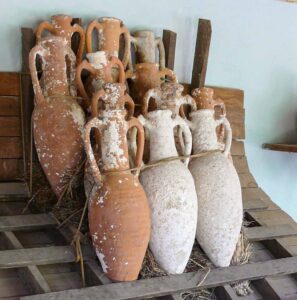
The amphorae were designed so that they could be transported vertically and tightly adjacent to each other. Thanks to this, they did not fall over even in poor conditions at sea. In this particular case, the load was arranged in rows along the sides. It is possible that there was a narrow passage in between. This arrangement can be seen to this day despite the passage of two thousand years and the complete decomposition of wood around the amphorae. Of course, they are currently overturned, but you can still see how thoughtfully such ships were loaded.
Further research on the Roman wreck
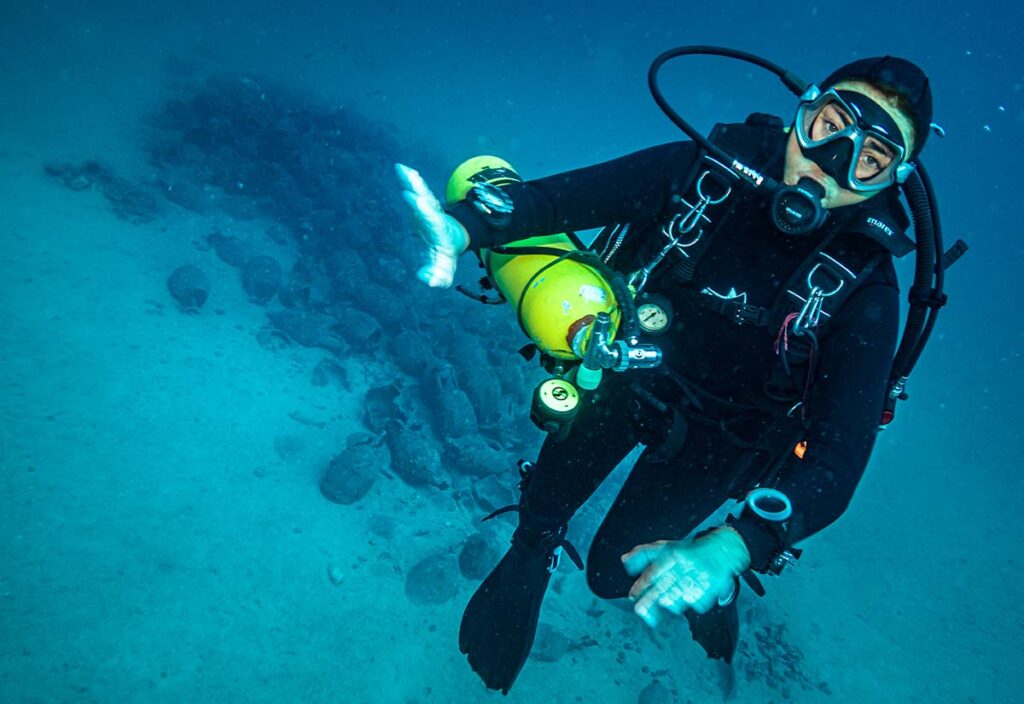
The next phase of research is the slow excavation of the wreckage with the help of ejectors, i.e. special machines resembling underwater vacuum cleaners. The first preliminary excavations showed that the wreck is even larger than archaeologists expected. Tea believes that under the sand and sediments we will find well-preserved wooden elements of the hull, as well as objects of everyday life of sailors. Thanks to them, we will learn not only about the history of the ship itself, but also about the history of ordinary people living on the surrounding islands.
In addition, a careful complete cleaning of several amphorae may allow to determine where they came from, because just as beverage manufacturers now place their labels on bottles, in ancient times they placed their seals on amphorae. This will allow us to determine what trade contacts the inhabitants of the local islands had with other ports of the Mediterranean. Besides, it is still not really resolved whether the amphorae were the only cargo carried on this ship. All we know for now is that hundreds of amphorae have been found and that archaeologists will dig further…
Mariusz Milka and Ewelina Heil

